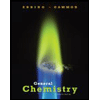
Mastering Chemistry with Pearson eText -- Standalone Access Card -- for Introductory Chemistry (6th Edition)
6th Edition
ISBN: 9780134565927
Author: Nivaldo J. Tro
Publisher: PEARSON
expand_more
expand_more
format_list_bulleted
Concept explainers
Textbook Question
Chapter 8, Problem 55E
For the reaction shown, find the limiting reactant for each of the initial quantities of reactants.
23Li(s)+F2(g)→2LiF(s)
a. 1.0 g Li; 1.0 g F2
b. 10 .5 g Li; 37.2 g F2
c. 2 .85 × 103g Li; 6.279× 103F2
Expert Solution & Answer
Learn your wayIncludes step-by-step video

schedule12:09
Students have asked these similar questions
How to solve
Indicate the concentration and ionic strength ranges to which the Debye-Huckel equation can be applied. And the Davies equation?
If the ionic strength (I) of a solution is very low, the Debye-Huckel equation is used. If I is higher, the Davies equation is used. What is the correct value for I to use one or the other?
Chapter 8 Solutions
Mastering Chemistry with Pearson eText -- Standalone Access Card -- for Introductory Chemistry (6th Edition)
Ch. 8 - Q1. Sulfur and fluorine react to form sulfur...Ch. 8 - Hydrogen chloride gas and oxygen gas react to form...Ch. 8 - Sodium reacts with fluorine to form sodium...Ch. 8 - Consider the hypothetical reaction shown here. If...Ch. 8 - Prob. 5SAQCh. 8 - Prob. 6SAQCh. 8 - Sodium and chlorine react to form sodium chloride....Ch. 8 - A reaction has a theoretical yield of 22.8 g. when...Ch. 8 - Titanium can be obtained from its oxide by the...Ch. 8 - Which statement best describes an exothermic...
Ch. 8 - Consider the generic reaction: A+2BAB2Hrxn=155kJ...Ch. 8 - Q12. Hydrogen gas reacts with oxygen to form...Ch. 8 - Prob. 1ECh. 8 - Nitrogen and hydrogen can react to from ammonia:...Ch. 8 - 3. Write the conversion factor that you would use...Ch. 8 - 4. What is wrong with this statement in reference...Ch. 8 - 5 what is the general from of the solution map...Ch. 8 - 6. Consider the recipe for making tomato and...Ch. 8 - 7 In a chemical reaction, what is the limiting...Ch. 8 - Prob. 8ECh. 8 - In a chemical reaction, what are the actual yield...Ch. 8 - If you are given a chemical equation and specific...Ch. 8 - 11. Consider the generic chemical...Ch. 8 - Prob. 12ECh. 8 - What is the enthalpy of reaction (Hrxn)? Why is...Ch. 8 - Explain the relationship between the sign of Hrxn...Ch. 8 - Consider the generic chemical reaction: A+2BC How...Ch. 8 - Consider the generic chemical reaction: 2A+3B3C...Ch. 8 - 17. For the reaction shown, calculate how many...Ch. 8 - 18. For the reaction shown, calculate how many...Ch. 8 - 19. Dihydrogen monosulfide reacts with sulfur...Ch. 8 - 20. Chlorine gas reacts with fluorine gas...Ch. 8 - For each reaction, calculate how many moles of...Ch. 8 - 22. For each reaction, calculate how many moles of...Ch. 8 - 23. For the reaction shown, calculate how many...Ch. 8 - 24. For the reaction shown, calculate how many...Ch. 8 - Consider the balanced equation:...Ch. 8 - 26. Consider the balance equation:
Complete the...Ch. 8 - 27. Consider the unbalanced equation for the...Ch. 8 - 28. Consider the unbalanced equation for the...Ch. 8 - 29. Consider the unbalanced equation for the...Ch. 8 - 30. Consider the unbalanced equation for the...Ch. 8 - Prob. 31ECh. 8 - 32. For the reaction shown, calculate how many...Ch. 8 - For each of the reactions, calculate how many...Ch. 8 - 34. For each of the reactions, calculate how many...Ch. 8 - 35. For the reaction shown, calculate how many...Ch. 8 - 36. For the reaction shown, calculate how many...Ch. 8 - Prob. 37ECh. 8 - Consider the balanced equation for the combustion...Ch. 8 - 39. For each acid–base reaction, calculate how...Ch. 8 - 40. For each precipitation reaction, calculate how...Ch. 8 - Sulfuric acid can dissolve aluminum metal...Ch. 8 - Hydrochloric acid can dissolve solid iron...Ch. 8 - 43. Consider the generic chemical equation:
a....Ch. 8 - Prob. 44ECh. 8 - Prob. 45ECh. 8 - Prob. 46ECh. 8 - For the reaction shown, find the limiting reactant...Ch. 8 - For the reaction shown, find the limiting reactant...Ch. 8 - 49. For the reaction shown, calculate the...Ch. 8 - For the reaction shown, calculate the theoretical...Ch. 8 - Consider the generic reaction between reactants A...Ch. 8 - Consider the reaction between reactants S and O2:...Ch. 8 - Consider the reaction 4HCI(g)+O2(g)2H2O(g)+2Cl2(g)...Ch. 8 - 54. Consider the reaction
Each molecular diagram...Ch. 8 - 55. For the reaction shown, find the limiting...Ch. 8 - For the reaction shown, find the limiting reactant...Ch. 8 - For the reaction shown, calculate the theoretical...Ch. 8 - For the reaction shown, calculate the theoretical...Ch. 8 - 58. If the theoretical yield of a reaction is 24.8...Ch. 8 - If the theoretical yield of reaction is 0.118 g...Ch. 8 - 61. Consider the reaction between calcium oxide...Ch. 8 - Consider the reaction between sulfur trioxide and...Ch. 8 - Consider the reaction between NiS2 and O2:...Ch. 8 - Consider the reaction between HCI and O2...Ch. 8 - Lead ions can be precipitate form solution with...Ch. 8 -
Ch. 8 - Consider the reaction between TiO2 and C:...Ch. 8 - 68. Consider the raction between N2H4 and N2O4:
A...Ch. 8 - 69. Classify each process as exothermic or...Ch. 8 - 70. Classify each process as exothermic or...Ch. 8 - Consider the generic reaction: A+2BCHrxn=55kJ...Ch. 8 - Prob. 72ECh. 8 - Consider the equation for the combustion of...Ch. 8 - The equation for the combustion of CH4 (the main...Ch. 8 - 75. Octane (C8H18) is a component of gasoline that...Ch. 8 - 76. The evaporation of water is...Ch. 8 - Consider the reaction:...Ch. 8 - Prob. 78ECh. 8 - A solution contains an unknown mass of dissolved...Ch. 8 - 80. A solution contains an unknown mass of...Ch. 8 - 81. Sodium bicarbonate is often used as an antacid...Ch. 8 - Toilet bowl cleaners often contain hydrochloric...Ch. 8 - 83. The combustion of gasoline produces carbon...Ch. 8 - Many home barbecues are fueled with propane gas...Ch. 8 - Prob. 85ECh. 8 - 86. Magnesium ions can be precipitated from...Ch. 8 - Hydrogen gas can be prepared in the laboratory by...Ch. 8 - Sodium peroxide (Na2O2) reacts with water to form...Ch. 8 - Prob. 89ECh. 8 - Pure oxygen gas can be prepared in the laboratory...Ch. 8 - 91. Aspirin can be made in the laboratory by...Ch. 8 - 92. The combustion of liquid ethanol produces...Ch. 8 - Urea (CH4N2 O), a common fertilizer, can be...Ch. 8 - 94. Silicon, which occurs in nature as SiO2, is...Ch. 8 - 95. The ingestion of lead from food, water, or...Ch. 8 - Prob. 96ECh. 8 - The propane fuel (C3H8) used in gas barbecues...Ch. 8 - Charcoal is primarily carbon. Determine the mass...Ch. 8 - 99. A loud classroom demonstration involves...Ch. 8 - 100. A hydrochloric acid solution will neutralize...Ch. 8 - 101. Scientists have grown progressively more...Ch. 8 - Prob. 102ECh. 8 - What volume of air is needed to burn an entire...Ch. 8 - Have each member of your group choose a...Ch. 8 - 105. Consider the combustion of propane:
a....
Additional Science Textbook Solutions
Find more solutions based on key concepts
1. Which is a function of the skeletal system? (a) support, (b) hematopoietic site, (c) storage, (d) providing ...
Anatomy & Physiology (6th Edition)
45. An FM radio station broadcasts at a frequency of 100 MHz. What inductance should be paired with a 10 pF cap...
College Physics: A Strategic Approach (3rd Edition)
Write an equation that uses the products of photosynthesis as reactants and the reactants of photosynthesis as ...
Campbell Biology in Focus (2nd Edition)
A source of electromagnetic radiation produces infrared light. Which of the following could be the wavelength ...
Chemistry: The Central Science (14th Edition)
In cats, tortoiseshell coat color appears in females. A tortoiseshell coat has patches of dark brown fur and pa...
Genetic Analysis: An Integrated Approach (3rd Edition)
Carefully examine the common sedimentary rocks shown In Figure 2.13. Use these photos and the preceding discuss...
Applications and Investigations in Earth Science (9th Edition)
Knowledge Booster
Learn more about
Need a deep-dive on the concept behind this application? Look no further. Learn more about this topic, chemistry and related others by exploring similar questions and additional content below.Similar questions
- In both the Debye-Huckel equation and the Davies equation, there is a constant A. I see that sometimes it appears as 0.51 and other times as 1.02. Explain why one or the other value is used.arrow_forwardThe two equations are forms of the Davies equation, used in thermodynamics for activity coefficients: ال log Y₁ = -Az² - 0,31 log = Az² - 0,31 1 + √Ĩ 1 + √√ k These equations are consistent and imply that Yi = Is this last equation correct? karrow_forwardThe two equations are forms of the Davies equation, used in thermodynamics for activity coefficients: ال log Y₁ = -Az² - 0,31 log = Az² - 0,31 1 + √Ĩ 1 + √√ k These equations are consistent and imply that Yi = Is this last equation correct? karrow_forward
- For the Davies equation, both expressions are correct: log Y₁ = -Az² √i - 0,31 1 + √ k log- = Az - 0,31 k 1 + √Ĩarrow_forwardk In Davies' equation log y₁ = log- log y₁ = log | = -Az² + ✓// k A is a constant that always equals 1.02. Correct? - 0,31arrow_forwardIndicate whether the equality is true Yi How is it obtained? k%arrow_forward
- Indicate the relationship between the activity coefficient YA and the rate constant of a bimolecular reaction in solution k and the rate constant at infinite dilution ko.arrow_forwardDescribe the saline effect that occurs in solutions.arrow_forwardBriefly explain what the infinite dilution rate constant (k∞) consists of.arrow_forward
- The Davies equation corrects the Debye-Hückel limiting law for calculating the activity coefficient of an electrolyte in solution at relatively high concentrations. Mathematically, it is expressed as: log y₁ = -Az²? 1 + √Ĩ - 0,31) Is the formula correct?arrow_forwardDifferentiate between the concepts of "ionic salt effect" and "kinetic salt effect."arrow_forwardDifferentiate the concepts of “salino effect” and “salino kinetic effect”.arrow_forward
arrow_back_ios
SEE MORE QUESTIONS
arrow_forward_ios
Recommended textbooks for you
 Chemistry: The Molecular ScienceChemistryISBN:9781285199047Author:John W. Moore, Conrad L. StanitskiPublisher:Cengage Learning
Chemistry: The Molecular ScienceChemistryISBN:9781285199047Author:John W. Moore, Conrad L. StanitskiPublisher:Cengage Learning Chemistry & Chemical ReactivityChemistryISBN:9781337399074Author:John C. Kotz, Paul M. Treichel, John Townsend, David TreichelPublisher:Cengage Learning
Chemistry & Chemical ReactivityChemistryISBN:9781337399074Author:John C. Kotz, Paul M. Treichel, John Townsend, David TreichelPublisher:Cengage Learning Chemistry & Chemical ReactivityChemistryISBN:9781133949640Author:John C. Kotz, Paul M. Treichel, John Townsend, David TreichelPublisher:Cengage Learning
Chemistry & Chemical ReactivityChemistryISBN:9781133949640Author:John C. Kotz, Paul M. Treichel, John Townsend, David TreichelPublisher:Cengage Learning General Chemistry - Standalone book (MindTap Cour...ChemistryISBN:9781305580343Author:Steven D. Gammon, Ebbing, Darrell Ebbing, Steven D., Darrell; Gammon, Darrell Ebbing; Steven D. Gammon, Darrell D.; Gammon, Ebbing; Steven D. Gammon; DarrellPublisher:Cengage Learning
General Chemistry - Standalone book (MindTap Cour...ChemistryISBN:9781305580343Author:Steven D. Gammon, Ebbing, Darrell Ebbing, Steven D., Darrell; Gammon, Darrell Ebbing; Steven D. Gammon, Darrell D.; Gammon, Ebbing; Steven D. Gammon; DarrellPublisher:Cengage Learning Introductory Chemistry: A FoundationChemistryISBN:9781285199030Author:Steven S. Zumdahl, Donald J. DeCostePublisher:Cengage Learning
Introductory Chemistry: A FoundationChemistryISBN:9781285199030Author:Steven S. Zumdahl, Donald J. DeCostePublisher:Cengage Learning ChemistryChemistryISBN:9781305957404Author:Steven S. Zumdahl, Susan A. Zumdahl, Donald J. DeCostePublisher:Cengage Learning
ChemistryChemistryISBN:9781305957404Author:Steven S. Zumdahl, Susan A. Zumdahl, Donald J. DeCostePublisher:Cengage Learning

Chemistry: The Molecular Science
Chemistry
ISBN:9781285199047
Author:John W. Moore, Conrad L. Stanitski
Publisher:Cengage Learning

Chemistry & Chemical Reactivity
Chemistry
ISBN:9781337399074
Author:John C. Kotz, Paul M. Treichel, John Townsend, David Treichel
Publisher:Cengage Learning

Chemistry & Chemical Reactivity
Chemistry
ISBN:9781133949640
Author:John C. Kotz, Paul M. Treichel, John Townsend, David Treichel
Publisher:Cengage Learning

General Chemistry - Standalone book (MindTap Cour...
Chemistry
ISBN:9781305580343
Author:Steven D. Gammon, Ebbing, Darrell Ebbing, Steven D., Darrell; Gammon, Darrell Ebbing; Steven D. Gammon, Darrell D.; Gammon, Ebbing; Steven D. Gammon; Darrell
Publisher:Cengage Learning

Introductory Chemistry: A Foundation
Chemistry
ISBN:9781285199030
Author:Steven S. Zumdahl, Donald J. DeCoste
Publisher:Cengage Learning

Chemistry
Chemistry
ISBN:9781305957404
Author:Steven S. Zumdahl, Susan A. Zumdahl, Donald J. DeCoste
Publisher:Cengage Learning
Bonding (Ionic, Covalent & Metallic) - GCSE Chemistry; Author: Science Shorts;https://www.youtube.com/watch?v=p9MA6Od-zBA;License: Standard YouTube License, CC-BY
Stoichiometry - Chemistry for Massive Creatures: Crash Course Chemistry #6; Author: Crash Course;https://www.youtube.com/watch?v=UL1jmJaUkaQ;License: Standard YouTube License, CC-BY